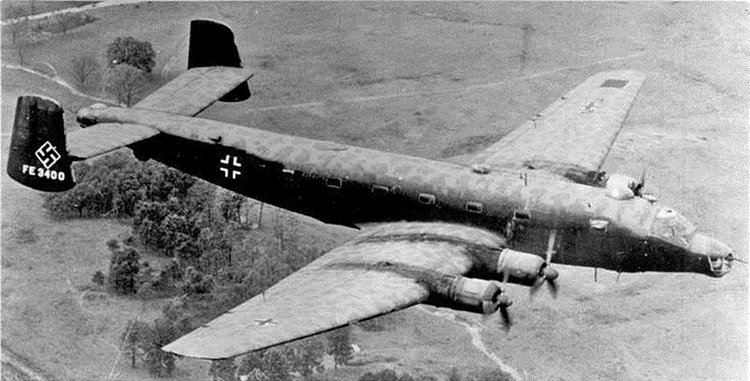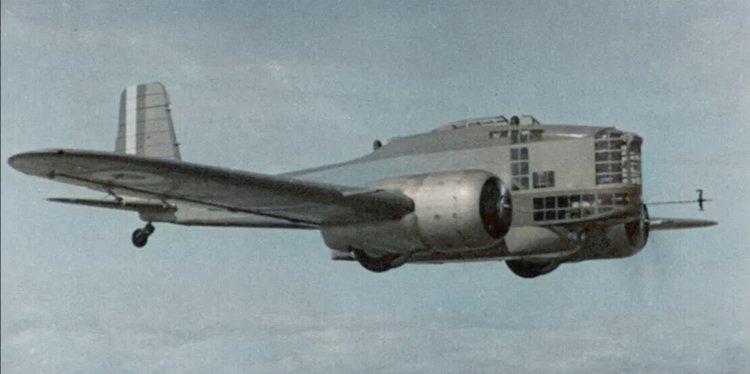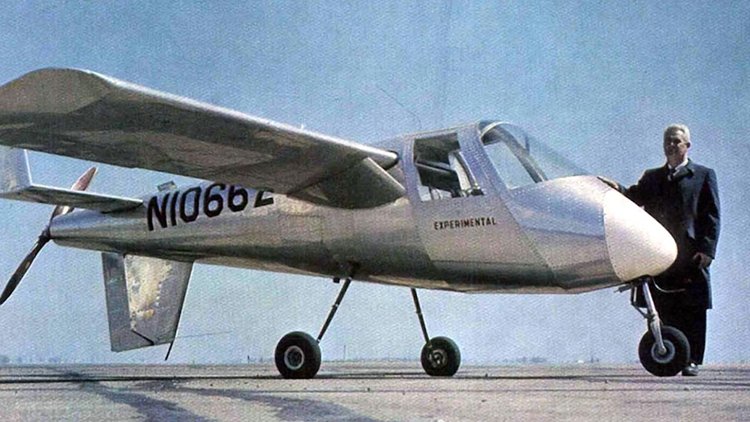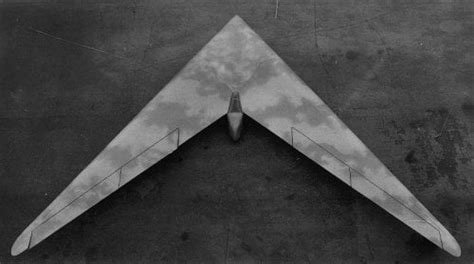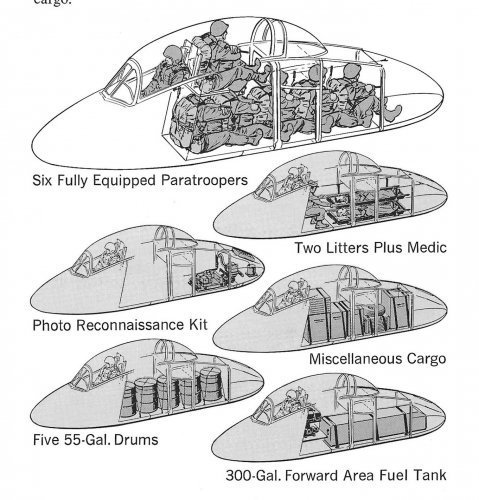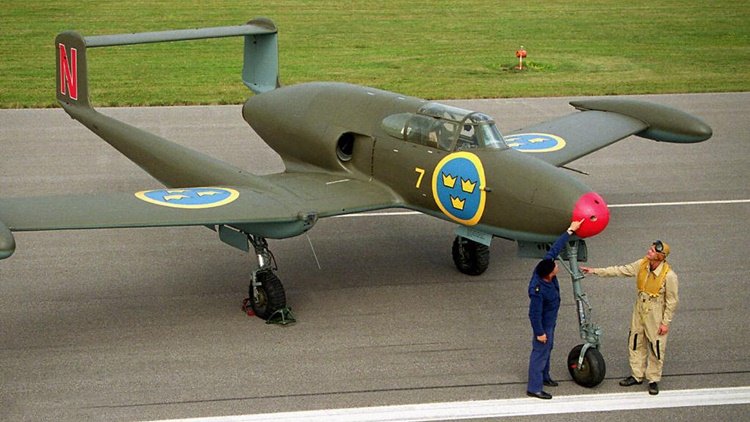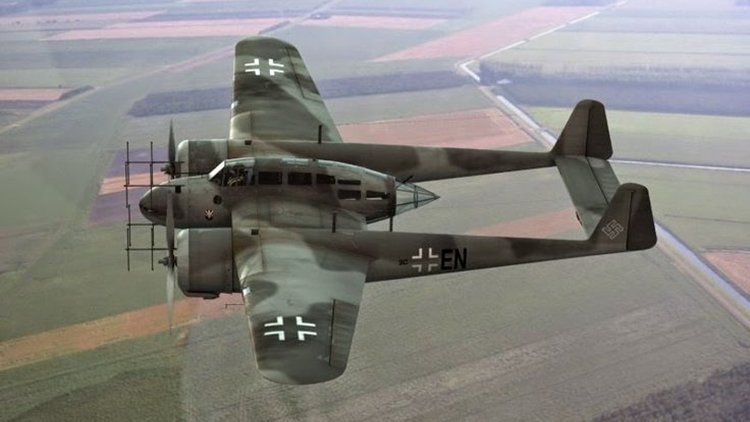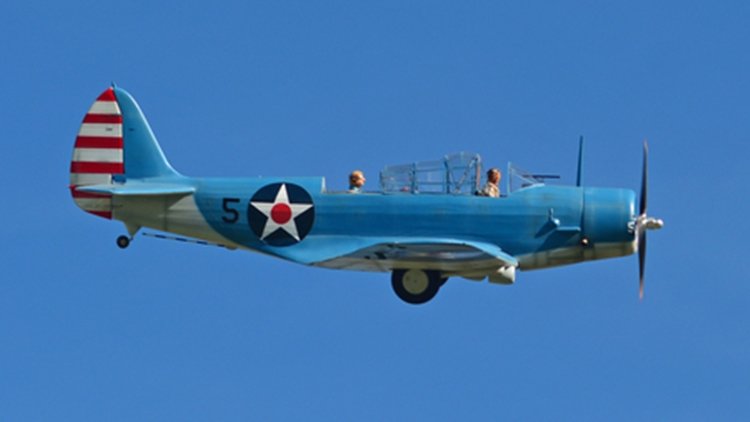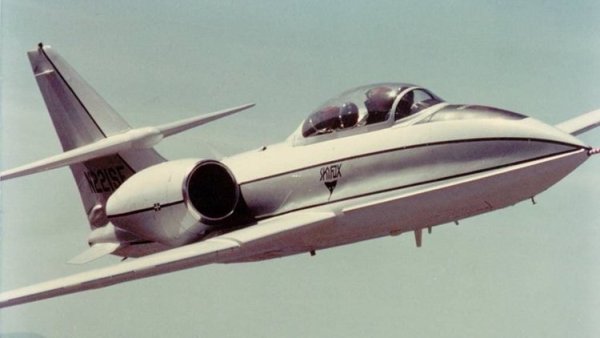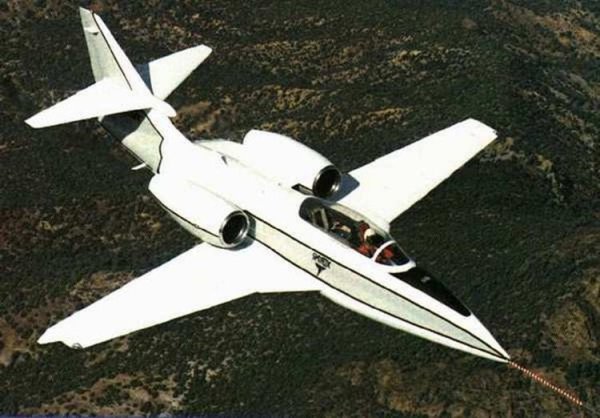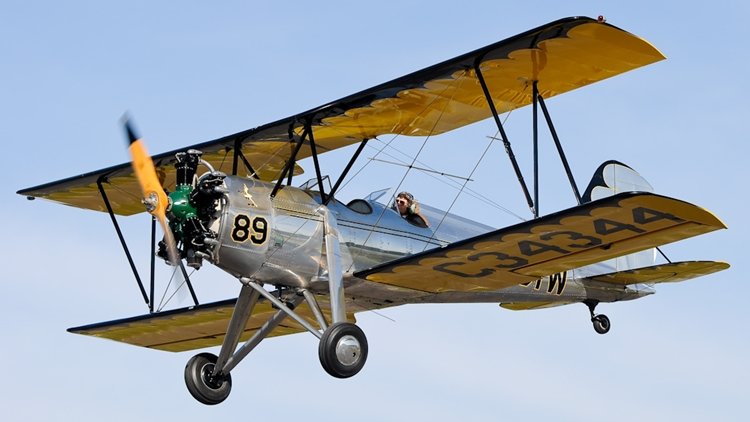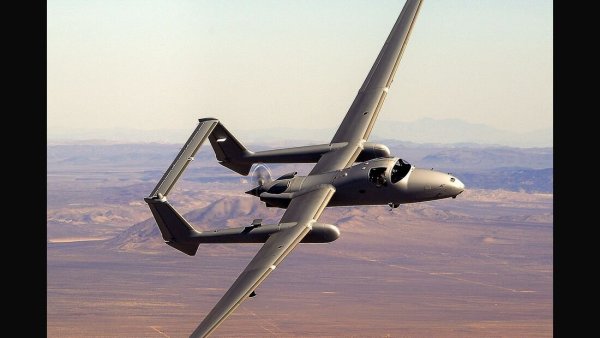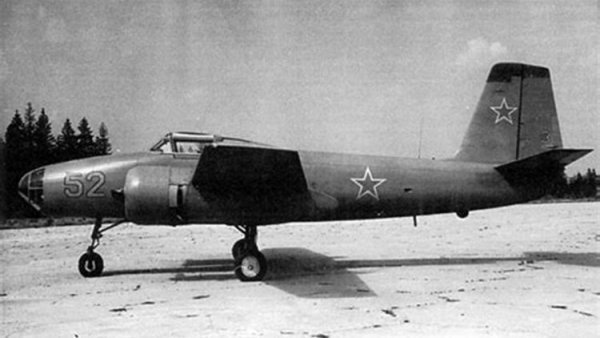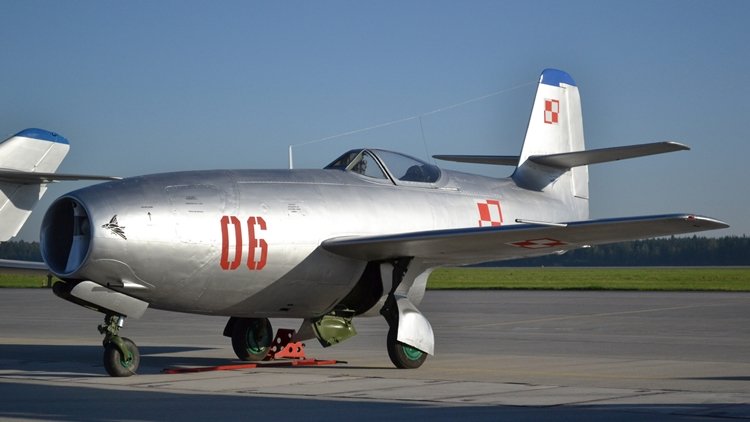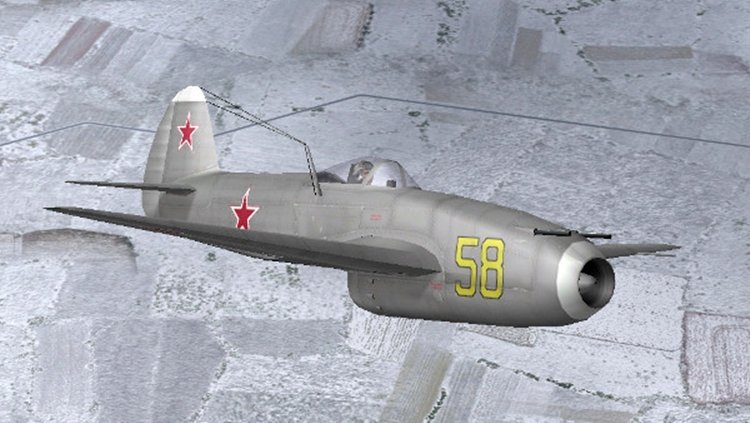-
Posts
7,574 -
Joined
-
Last visited
-
Days Won
67
Content Type
Profiles
Forums
Gallery
Downloads
Blogs
Events
Store
Aircraft
Resources
Tutorials
Articles
Classifieds
Movies
Books
Community Map
Quizzes
Videos Directory
Everything posted by red750
-
The Junkers Ju 290 was a large German, four-engine long-range transport, heavy bomber and maritime patrol aircraft used by the Luftwaffe late in World War II. It was developed from an airliner. The Junkers 290 was developed directly from the Ju 90 airliner, versions of which had been evaluated for military purposes, and was intended to replace the relatively slow Focke-Wulf Fw 200 Condor, which by 1942 was proving increasingly vulnerable when confronted with Royal Air Force aircraft. The Fw 200's airframe lacked sufficient strength for the role in any case. The Ju 290 was also intended to meet the need for large transport aircraft. A bomber version, the A-8, was planned, but never built. Design was headed by Konrad Eicholtz. The development programme resulted in the Ju 290 V1 prototype BD+TX, which first flew on 16 July 1942. It featured a lengthened fuselage, more powerful engines, and a Trapoklappe - a hydraulically operated rear loading ramp. Both the V1 and the first eight A-1 production aircraft were unarmed transports. The need for heavy transports saw the A-1s pressed into service as soon as they were completed. Several were lost in early 1943, including one taking part in the Stalingrad Airlift, and two flying supplies to German forces in Tunisia, and arming them became a priority. The urgent need for Ju 290s in the long-range maritime reconnaissance role was now also high priority, and resulted in the Ju 290A-2. Three A-1 aircraft were converted to A-2 specification on the assembly line. Production was slow due to the modifications necessary and the installation of strong defensive armament. The A-2 was fitted with FuG 200 Hohentwiel low-UHF band search radar and a dorsal turret fitted with a 20 mm MG 151 cannon. The Hohentwiel radar was successfully used to locate Allied convoys at ranges of up to 80 km (50 mi) from an altitude of 500 m (1,600 ft) or 100 km (62 mi) from an altitude of 1,000 m (3,300 ft). It allowed the Ju 290 to track convoys while remaining out of range of anti-aircraft fire. On 26 November 1943, Ju 290 A-5, no. 0170, along with many other new aircraft and prototypes, was shown to Adolf Hitler at Insterburg, East Prussia. Hitler was impressed by its potential and told Göring that he wanted a Ju 290 for his personal use. A Ju 290 was not however assigned to the Fliegerstaffel des Fuehrers (FdF) until late 1944, when an A-7 was supplied, works number 0192, which had formerly been assigned to FAGr 5. Modifications were completed by February 1945 at the FdF's base at Pocking, Bavaria, a Stammkennzeichen alphabetic designation code of KR+LW being applied. Hitler's pilot, Hans Baur, tested the aircraft, but Hitler never flew in it. The aircraft was fitted with a special passenger compartment in the front of the aircraft for Hitler, which was protected by 12 mm (.5 in) armour plate and 50 mm (2 in) bulletproof glass. A special escape hatch was fitted in the floor and a parachute was built into Hitler's seat; in an emergency it was intended that he would put on the parachute, pull a lever to open the hatch, and roll out through the opening. This arrangement was tested using life-size mannequins. Hans Baur flew the aircraft to Munich-Riem airport on 24 March 1945, landing just as an air-raid alert was sounded. He went home after parking it in a hangar but on returning to the airport, he discovered that both hangar and aircraft had been destroyed by American bombers. Ju 290Z Zwilling Junkers project documents from 1942 to 1944 indicate that a Zwilling (German: 'twin') variant was proposed. It was to be composed of two Ju 290 fuselages and powered by eight BMW 9-801 engines; two mounted on each outboard wing and four on the inboard wing. It was to carry a single Messerschmitt Me 328 jet parasite fighter on top of the right fuselage. The Ju 290Z was canceled in favor of the Ju 390. For more details of the development, operational history and variants, click here. The only photos of the Ju 290Z Zwilling available are photos of a model. Specifications (Ju 290 A-5)
-
The Bréguet 460 Vultur was a French bomber of the 1930s. Few of these twin-engined monoplanes and its variant, the Breguet 462 Bréguet , were built. At least one Breguet 460 was sold to the Spanish Republican Air Force during the Spanish Civil War. The Bréguet 460 was a bomber, initially labelled as Multiplace de Combat, a multifunctional aircraft, by the French aviation authorities. Eventually the prototype was modified in 1934, departing from the parameters set for its predecessor, the Breguet 413, in order to meet the requirements of a high-speed bomber for the French Air Force. The resulting aircraft was a monoplane fitted with two powerful radial Gnome et Rhône 14Kjrs engines, having a more aerodynamic appearance, although it kept the tail of the obsolete Breguet 413. Owing to technical difficulties, production was delayed and when the first prototype of the Bréguet 460 Vultur flew, it could not achieve the 400 km/h (250 mph) required for a high-speed bomber. Thus, the French Air Ministry lost interest in this unit and concentrated on projects by other companies, such as the Amiot 340 and the LeO 45. These aircraft, however, would not be ready until three years later. The outbreak of the Spanish Civil War provided the French aircraft industry with a good opportunity both for getting rid of obsolete aircraft and for testing new developments. Therefore, it is in this context that the Bréguet 460 prototypes ended up in the Spanish Republican Air Force. One of the units seen in a picture of the Spanish conflict has an improved, more modern tail of the same type that would be used later for the Breguet 470 Fulgur airliner. The number and the fate of the Bréguet 460 Vultur units in the Spanish Republican Air Force are obscure as is common with most of the flying units of the loyalist air arm during the conflict. It is known that one of these aircraft was based at the Celrà airfield towards the end of the conflict and that it belonged to the Night Flight Group no. 11, which comprised the Vultur and two Bloch MB.210. This particular Breguet 460 was hit by the nationalist cruiser "Canarias" and crashed in the sea near L'Escala and all the crew perished in the crash. The Bréguet Br 462 was a modernized version of the Bréguet 460, although still very similar, that made its first test flight towards the end of 1936. The front part of the fuselage was redesigned to look more aerodynamic and the aircraft was fitted with two Gnome-Rhône 14N-0/N-1 engines that allowed it to reach a speed of 402 km/h (250 mph). Flight described it as similar to the Bréguet 461 that was supplied to Japan in 1935. A planned installation of 1,350 hp (1,010 kW) engines was expected to give it a speed of around 300 mph (480 km/h). Bombload was 1076 kg. Defensive armament was a forward-firing 20 mm (0.79 in) cannon and two rear-firing machine guns. Only three Bréguet 462s were built. Two of them served in the Vichy French Air Force where they did not see much action and were scrapped in 1942. Variants Bre 460 Light bomber and strike aircraft with two Gnome-Rhône 14Kdrs1 radial engines. One prototype built. Bre 460 M5 1935 design. Light bomber and strike aircraft powered by two Gnome-Rhône 14Kdrs radial engines. Br 462 B4 A modernized version of the Bre 460. Only three built.
-
The Fairchild Dornier 728/928 family was a series of jet-powered regional airliners that was being developed by German-American aviation conglomerate Fairchild Dornier. It was a relatively ambitious bid to develop a group of aircraft that would have seated between 50 and 110 passengers, supplementing the existing 328JET series, a smaller regional jet. The 728/928 family is a monoplane design with fixed wings in low wing configuration and two engines mounted under the wings. It has a retractable undercarriage (or landing gear) in tricycle configuration. On 21 March 2002, the roll-out of the first 728 took place. The company planned its maiden flight to occur during the summer of 2002 and for deliveries to commence during mid-2003 to the launch customer Lufthansa Cityline. During July 2003, D'Long International Strategic Investment Group of Xinjiang, China showed an interest in purchasing a stake the project. A new entity, Fairchild Dornier Aeroindustries, was formed with the aim of completing development of the aircraft, however, this company also filed for bankruptcy during 2004. During this brief revival, no additional aircraft were produced, although structural tests in Dresden were commenced during 2003. Number built 3 prototypes built to various stages of completion 928 Planned to follow the 728 into service, the 928 had a stretched fuselage that would have enabled the aircraft to achieve a passenger capacity of 95 to 110 seats. The first flight was scheduled for late 2003 with entry into service in 2005. The 928 featured an increased wing span and more powerful GE CF-34-10 engines. A 928-100 version, as well as a 928-200 version that had an increased maximum takeoff weight (MTOW), was planned.
-
The Convair YB-60 was a prototype heavy bomber built by Convair for the United States Air Force in the early 1950s. It was a purely jet-powered development of Convair's earlier mixed-power B-36 Peacemaker. On 25 August 1950, Convair issued a formal proposal for a swept-winged version of the B-36 with all-jet propulsion. The Air Force was sufficiently interested that on 15 March 1951, it authorized Convair to convert two B-36Fs (49-2676 and 49-2684) as the B-36G. Since the aircraft was so radically different from the existing B-36, the designation was soon changed to YB-60. The YB-60 had 72% parts commonality with its piston-engined predecessor. The fuselages of the two aircraft were largely identical although the radar and bombing systems were located in a removable nose section as a result of the poor reliability of the B-36 installation. For initial flight testing a more streamlined nose with an instrumented boom was fitted; a wedge-shaped insert was added just outboard of the main landing gear to increase wing sweep and the tail surfaces were swept to match. The swept wings also used many B-36 parts. A steerable tail wheel was added to prevent the aircraft tipping backwards. It was not necessarily extended when on the ground but depended on how the aircraft was loaded. Convair YB-60 serial number 49-2676 made its maiden flight on 18 April 1952, piloted by Beryl Erickson. The Boeing YB-52 beat the Convair aircraft into the air by three days. The YB-60 was approximately 100 mph (160 km/h) slower than the YB-52 and also had significant handling problems, due to its controls having been designed for slower operating speeds. It did carry a heavier bomb load — 72,000 lb (33,000 kg) against 43,000 lb (20,000 kg) for the YB-52 — but the Air Force did not see the need for the extra capacity, given the YB-60's other drawbacks. Later, "big belly" modifications increased the B-52's bomb load to 60,000 pounds (27,000 kg). The flight test programs were canceled on 20 January 1953, with 66 flying hours accumulated. The second prototype was nearing completion but its engines had not been installed and other equipment installations had not been completed. Since Convair completed their prototype contract satisfactorily, both YB-60s were formally accepted by the Air Force in 1954. The operational aircraft never flew again, and both airframes were scrapped by July.
-
Yes. Was going to put it into 3-axis until I saw that.
-
The Lesher Nomad is an innovative two-place homebuilt aircraft. Designer Edgar J Lesher had previously worked at Stinson Aircraft Company in Wayne, Michigan on the Stinson 106 Skycoach. The Skycoach was a four-place aircraft with a pusher propeller, a configuration which captured Lesher's imagination. In August 1958, he attended one of the early Experimental Aircraft Association Fly-Ins. The homebuilt aircraft he saw there inspired him to design one himself. Remembering the Skycoach, he began the design of an all-aluminum two-place, side-by-side, pusher propeller aircraft. Construction began in February 1959. In October 1961, after 5,000 hours of construction, he first flew his aircraft, the Lesher Nomad (N1066Z) at Willow Run Airport in Ypsilanti, Michigan. A novel design feature was his use of a Dodge Flexidyne Coupling in the drive train to dampen torsional vibrations. The aircraft was powered by a 100 hp Continental O-200 engine driving a 72-inch Hartzell ground-adjustable propeller. Lesher flew the Nomad to the 1962 EAA Fly-In in Rockford, Illinois, where the design attracted a lot of interest. In 1964, flying Nomad, he took the grand prize in the AC Spark Plug Rally. The aircraft was regularly flown until Lesher's death in 1998. The aircraft is on display in the atrium of the Francois-Xavier Bagnoud building at the University of Michigan.
-
The Horten H.XIII was an experimental flying wing aircraft designed by the Horten brothers during World War II. The H.XIIIa was an unpowered glider with wings swept backwards at 60°. It was a technology demonstrator to examine the low speed handling of highly swept wings, for the development of a jet fighter which was expected to exceed Mach 1, the H.XIIIb. The small bit in the centre of the trailing edge is the cockpit.
-
-
The Lockheed CL-760 LARA, standing for Light Armed Reconnaissance Aircraft, was conceived in the 1960s, this aircraft was Lockheed’s answer to the U.S. Army’s need for a novel kind of light tactical aircraft. It was envisioned to fulfill multiple roles such as reconnaissance, close air support, and interdiction missions. The CL-760 project serves as a testament to the advancement of military aviation technology and strategies during the Cold War period, as well as showcasing Lockheed’s capacity for innovative aircraft design. The 1960s were a period of rapid advancement in military aviation technology, fueled by the tensions of the Cold War. The United States military, particularly the Army, sought to enhance its tactical capabilities with aircraft that could provide close support to ground troops, perform reconnaissance, and engage in light strike missions. This period saw the development of several aircraft designed to fulfill similar roles, such as the OV-10 Bronco and the Cessna A-37 Dragonfly. The CL-760 lost out to the OV-10 Bronco.
-
The FAA proposed a new airworthiness directive earlier this year to address a potential flaw in Boeing jets, DailyMail.com can reveal. According to the FAA proposal, the issue involved an electrical fault on the company's 777 jets that, if left unaddressed, could cause fuel tanks on the planes' wings to catch fire and explode. Discovery of the flaw exposes that nearly 300 more Boeing planes are potentially at risk, including jets used by United and American Airlines, according to the notice by the Federal Aviation Administration.
-
The Saab 21R was a Swedish fighter/attack aircraft developed and produced by Svenska Aeroplan AB (SAAB). It was a jet-powered development of the piston-engined SAAB 21 and was the first jet aircraft to be produced by Saab. The R-suffix stands for reaktion (reaction), referencing reaktionsdrift (jet power) or reaktionsmotor (jet engine). Along with the Soviet Yakovlev Yak-15, the 21R was one of only two jet fighters to have been successfully converted from piston-powered aircraft. Sweden was under threat during the Second World War, and ordered SAAB to develop an advanced fighter. The result was an unorthodox twin-boom pusher, with a low wing, tricycle landing gear, and a heavy forward-firing armament. Several options were then explored to improve its performance, leading to a jet-powered version. During 1947, SAAB began converting the piston-engined J 21s to jet propulsion, which required extensive modifications. 124 aircraft were planned, however this was reduced to 64 and they were instead mainly used as fighter-bombers. It saw service in the late 1940s and early 1950s before it was replaced by a new generation of fighters designed from the onset with jet propulsion, such as the de Havilland Vampire and the Saab 29 Tunnan. During the early stages of the Second World War, Sweden was concerned that its neutrality and its independence could be threatened by one of the belligerent powers, and so enacted a series of emergency measures to increase its military's preparedness and deterrence value against potential aggressors. Between 1939 and 1941, the Swedish Air Force committed itself to a major expansion programme, which included the procurement of large numbers of foreign and locally developed fighters. As a consequence of the conflict, few nations possessed available production capacity or a willingness to supply modern fighters to Sweden, being a relatively small neutral country. While Sweden's own domestic production capability would be insufficient until at least 1943, Sweden would have to develop its own first-rate designs to meet its needs. In 1941, in response to Swedish Air Force requirements, the Swedish aviation company SAAB commenced work on a radical new fighter.The company envisioned an unorthodox twin-boom pusher configuration fighter aircraft, featuring a low wing, a tricycle landing gear, and with a heavy forward-firing armament. It was powered by a licensed version of the new German Daimler-Benz DB 605B inline piston engine, which was refined and built by Svenska Flygmotor AB. The Swedish Air Force designated it the J 21, and a prototype was flown on 30 July 1943. By 1945, options were being explored to improve its performance. Many of these involved the substitution of the 605B engine with a more powerful powerplant. During the first half of the year, a variant was planned with a 2,000 hp (1,500 kW) Rolls-Royce Griffon engine which would have raised the top speed to 416 mph (669 km/h). Other projects, such as the SAAB 27, were intended to use the Griffon as well, but by the end of the year, all work on the piston-engine design was abandoned. In parallel with the piston-engine studies, SAAB and other Swedish companies had been evaluating a new type of engine - the jet engine. Two early studies, RX 1 and RX 2, had been studied, both of which being twin-boom aircraft similar to the 21. Recognising the Swedish Air Force's enthusiasm for a jet-powered aircraft for late 1945, SAAB decided to produce a version of the 21 harnessing jet propulsion. A design study was initiated for converting the J 21A to jet power. It was recognized that Sweden would otherwise be left behind while nations such as the United Kingdom already had the Gloster Meteor and de Havilland Vampire in production. The design study was proceeding in late 1945 despite no specific engine having been chosen, but the opportunity came up to purchase a license to manufacture the "Goblin 2" turbojet engine in Sweden. This was the first jet engine to be used by the Swedish Air Force, who designated it as the RM1. The first flight of Saab's first jet aircraft, a converted J 21, was on 10 March 1947, powered with a single Goblin 2 engine. The results of the flight test programme were largely satisfactory. During 1947, SAAB began to receive piston-engined J 21s to convert them to jet propulsion. This requiring each aircraft to be extensively modified. In all, in over 50 per cent of the airframe, tailplane and wing was changed and, each of them was equipped with a single British-sourced de Havilland Goblin turbojet engine, which replaced the DB 605B and propeller unit. It became the Swedish Air Force's first jet aircraft. In light of the extensive changes, rebuilt 21s were redesignated J 21R. Variants J 21RA – First production series, intended as fighters, powered by British-built de Havilland Goblin II engines, 34 built in 1950 (including four prototypes) A 21RA – J 21RA redesignated as attackers in 1951 and modified to carry external attack ordnance, retired in 1953 J 21RB – Second production series, intended as fighters, powered by Swedish-built de Havilland Goblin III engines, 30 built between 1950 and 1952 A 21RB – J 21RB redesignated as attackers in 1951 and modified to carry external attack ordnance, retired in 1956 For more details of development and operational history, click here.
-
The Fokker G.I was a Dutch twin-engined heavy fighter aircraft comparable in size and role to the German Messerschmitt Bf 110. Although in production prior to World War II, its combat introduction came at a time the Netherlands were overrun by the Germans. The few G.Is that were mustered into service were able to score several victories. Some were captured intact after the Germans had occupied the Netherlands. The remainder of the production run was taken over by the Luftwaffe for use as trainers. The G.I, given the nickname le Faucheur ("The Reaper" in French), was designed as a private venture in 1936 by Fokker chief engineer Dr. Schatzki. Intended for the role of jachtkruiser, "heavy" fighter or air cruiser, able to gain air superiority over the battlefield as well as being a bomber destroyer, the G.1 would fulfill a role seen as important at the time, by advocates of Giulio Douhet's theories on air power. The Fokker G.I utilized a twin-engined, twin-boom layout that featured a central nacelle housing two or three crew members (a pilot, radio operator/navigator/rear gunner or a bombardier) as well as a formidable armament of twin 23 mm (.91 in) Madsen cannon and a pair of 7.9 mm (.31 in) machine guns (later eight machine guns) in the nose and one in a rear turret. Besides its main mission, the G.1 could be configured for ground attack and light bombing missions (it could carry a bomb load of one 400 kg/882 lb bomb or combinations of two 200 kg/441 lb or 10 26 kg/57 lb bombs). The design and construction of the prototype (registered as X-2) was completed in just seven months. At its introduction at the Paris Air Show in November 1936, even before its first flight, the G.I was a sensation, appearing in a purple and yellow finish (evocative of the Spanish Republican colors, thought to be Fokker's first export customer). Like all Fokker aircraft of the period, the G.I was of mixed construction; the front of the central pod were built around a welded frame, covered with aluminium plating. The back of the central pod, however, as well as the wings, were completely constructed with wood. The G.I prototype, powered by 485 kW (650 hp) Hispano-Suiza 14AB-02/03 engines, had its first flight at Welschap Airfield, near Eindhoven on 16 March 1937 with Karel Mares at the controls. Later, Emil Meinecke took over much of the test flights. The maiden flight went well, but a subsequent test flight in September 1937 ended with a supercharger explosion that nearly caused the loss of the prototype. The accident prompted a replacement of the Hispano-Suiza engines with 559 kW (750 hp) Pratt & Whitney SB4-G Twin Wasp Junior engines. For details of operational history and variants, click here.
-
Crashing After Landing.. #pilotdebrief #aviation #aviationlovers... WWW.FACEBOOK.COM Crashing After Landing.. #pilotdebrief #aviation #aviationlovers #pilot #pilotsoftiktok #airplanes. Pilot Debrief · Original audio
-
The Douglas TBD Devastator was an American torpedo bomber of the United States Navy. Ordered in 1934, it first flew in 1935 and entered service in 1937. At that point, it was the most advanced aircraft flying for the Navy, however by the time of the US entry into World War 2, the TBD was already obsolete. The Devastator performed well early war, most notably in the Battle of Coral Sea, but earned notoriety for a catastrophic performance during the Battle of Midway in which 41 Devastators recorded zero torpedo hits with only six surviving to return to their carriers. Although much of the Devastator's dismal performance was later attributed to the many well-documented defects in the US Mark 13 torpedo, the aircraft was withdrawn from frontline service after Midway, being replaced by the Grumman TBF Avenger. The Douglas XTBD-1 was ordered on 30 June 1934 after being one of the winners of a US Navy competition for new bombers to operate from its aircraft carriers. Other aircraft also ordered for production as a result of the competition included the Brewster SBA, the Vought SB2U Vindicator, and the Northrop BT-1, the last of which would evolve into the Douglas SBD Dauntless. The Great Lakes XB2G, Great Lakes XTBG, Grumman XSBF, Hall XPTBH and Vought XSB3U were also tendered to the specification but were not developed beyond prototype status. The XTBD Devastator flew for the first time on 15 April 1935 while marking a number of "firsts" for the US Navy. It was the first American carrier-based monoplane to be widely used, the first all-metal naval aircraft, the first with a completely enclosed cockpit, the first with power-actuated (hydraulically) folding wings A semi-retractable landing gear was fitted, with the wheels protruding 10 in (250 mm) below the wings to potentially limit damage to the aircraft in a "wheels-up" landing. A crew of three was normally carried beneath a large "greenhouse" canopy almost half the length of the aircraft. The pilot sat in front; a rear gunner/radio operator took the rearmost position, while the bombardier occupied the middle seat. During a bombing run, the bombardier lay prone, sliding into position under the pilot to sight through a window in the bottom of the fuselage, using the Norden bombsight. 130 Devastators were built Fore more details of design and development, operational history and variants, click here.
-
🤣🤣👏👏 @iconicflightllc We all know it… Pilots daydreams about being an... WWW.FACEBOOK.COM 🤣🤣👏👏 @iconicflightllc We all know it… Pilots daydreams about being an ICON A5 pilot.✈️ Video from YouTube kevin409galv #ICONA5 #ICONAircraft #LightSportAircraft #LSA #SeaplaneLife...
-
The Boeing Skyfox is an American twin-engined jet trainer aircraft, a highly upgraded development of the Lockheed T-33. It was designed as a primary trainer to compete with and replace the Cessna T-37 Tweet. Besides its primary role as a trainer, the aircraft was envisioned to have other roles as well, including ground attack. The program was started by the Skyfox Corporation in 1983, and was acquired by Boeing in 1986. The program included the replacement of the Allison J33-A-35 turbojet by two Garrett TFE731-3A turbofans. It also included an extensive redesign of the airframe. Only one prototype aircraft was built, and the program was later canceled due to lack of customers.
-
The Northrop A-17, also known as the Northrop Model 8, a development of the Northrop Gamma 2F model, was a two-seat, single-engine, monoplane, attack bomber built in 1935 by the Northrop Corporation for the United States Army Air Corps. When in British Commonwealth service during World War II, the A-17 was called Nomad. The Northrop Gamma 2F was an attack bomber derivative of the Northrop Gamma transport aircraft, developed in parallel with the Northrop Gamma 2C, designated the YA-13 and XA-16. The Gamma 2F had a revised tail, cockpit canopy and wing flaps compared with the Gamma 2C, and was fitted with new semi-retractable landing gear. It was delivered to the United States Army Air Corps for tests on 6 October 1934, and after modifications which included fitting with a conventional fixed landing gear, was accepted by the Air Corps. A total of 110 aircraft were ordered as the A-17 in 1935. The resulting A-17 was equipped with perforated flaps, and had a fixed landing gear with partial fairings. It was fitted with an internal fuselage bomb bay, that carried fragmentation bombs, and external bomb racks. Northrop developed a new landing gear, this time completely retractable, producing the A-17A variant. This version was again purchased by the Army Air Corps, who placed orders for 129 aircraft. By the time these were delivered, the Northrop Corporation had been taken over by Douglas Aircraft Company, with export models being known as the Douglas Model 8. For operational history in 10 countries and details of 11 variants, click here.
-
The Meyers OTW (Out To Win) was a 1930s United States training biplane designed by Allen Meyers and built by his Meyers Aircraft Company from 1936 to 1944. In anticipation for a demand for training aircraft caused by the introduction of a civilian war training scheme (in which civil flying schools would provide primary training for the military), Allen Meyers designed the OTW and formed the Meyers Aircraft Company to build it. The OTW was a conventional biplane with tandem seating for two in open cockpits and a fixed tailwheel landing gear. The prototype was powered by a 125 hp (93 kW) Warner Scarab engine and it first flew on 10 May 1936. The aircraft was produced in two main variants; the OTW-145 powered by a 145 hp (108 kW) Warner Super Scarab, and the OTW-160 powered by a 160 hp (119 kW) Kinner R-5 engine. A total of 102 were built. Variants OTW-125 Production variant with 125hp (93kW) Warner Scarab engine. OTW-145 Production variant with 145hp (108kW) Warner Super Scarab engine. OTW-160 (Specifications below) Final production variant with 160hp (119kW) Kinner R-5 engine. OTW-KR One aircraft was re-engined with a 120hp (89kW) Ken-Royce 7G engine.
-
The Northrop Grumman Firebird is an intelligence gathering aircraft designed by Northrop Grumman's subsidiary Scaled Composites which can be flown remotely or by a pilot. At Scaled, it is known as the Model 355. It was unveiled on May 9, 2011. It was first flown in February 2010 and is considered to be an optionally piloted vehicle (OPV). In April 2022, Northrop Grumman announced it had suspended production of the Firebird, having failed to secure any export customers for the aircraft. However, company representatives left open the possibility of future production, stating that the aircraft would "remain available for interested customers." Only one had been built.
-

Cessna only just makes it to Bankstown 26/05/2024
red750 replied to kgwilson's topic in Aircraft Incidents and Accidents
From regosearch: Cessna 210MTurbo VH-MYW. Holder: SWANEPOEL, Johannes Jacob. -
The Yakovlev Yak-200 was a prototype Soviet multi-engine trainer built during the 1950s. A modified version was built as the Yak-210 for navigator training, but only one example of each was built before the program was cancelled in 1956.
-
The Yakovlev Yak-17 (Russian: Яковлев Як-17; USAF/DOD designation Type 16, NATO reporting name Feather) was an early Soviet jet fighter. It was developed from the Yak-15, the primary difference being tricycle landing gear. The trainer version, known as the Yak-17UTI (NATO reporting name Magnet), was the only Soviet jet trainer of the 1940s. Both aircraft were exported in small numbers and the Yak-17 was soon replaced by the far superior Mikoyan-Gurevich MiG-15 beginning in 1950. After the state acceptance trials of the Yak-15 in May 1947 recommended that the aircraft be modified with a tricycle landing gear more suitable for jet-powered aircraft, the Yakovlev design bureau began design of the Yak-15U or Yak-15U-RD-10 (uloochshenny - improved). The main gear had to be redesigned to place the wheels behind the aircraft's center of gravity. The main gear was moved behind the front spar, and when retracted filled most of the space between the spars. This caused a major redesign of the fuel tanks and reduced their capacity to just 680 liters (150 gallons). This necessitated the addition of two 200-liter (44 imp gal; 53 U.S. gal) drop tanks, which hung under the tip of each wing. The addition of the tip tanks required a redesign of the structure of the wing so that the aircraft could still maintain a load bearing of 12g. The vertical stabilizer was enlarged and a periscope was also added above the windscreen on most series aircraft. Armament, systems, and equipment were virtually unchanged. Production began in 1948. Total production of all Yak-15 and Yak-17 variants was 717. The Yak-17 was first publicly displayed at the Soviet Aviation Day of 1949, at Tushino Airfield. In operation, the Yak-17 had most of the same faults as its predecessor, including relatively low speed and range, and an unreliable engine (still based upon the German Junkers Jumo 004) with a complicated starting procedure. On the other hand, its handling was very simple, and similar to popular propeller fighters such as the Yak-3 and Yak-9. This made it an excellent transitional machine to jet fighters. As a result, the trainer version Yak-17UTI accounted for the majority of production, and almost all series-built Yak-17s were of this tandem, dual-control trainer version, which filled an important need in all Soviet air arms. Surviving Yak-17s can be viewed at the Central Air Force Museum at Monino, outside of Moscow and the Prague Aviation Museum at Kbely Airport, near Prague, Czech Republic. Surviving Yak-17UTIs include one example at the Polish Aviation Museum in Kraków and the Chinese Aviation Museum, near Beijing. Variants Yak-15U (Yak-15U-RD-10): Improved Yak-15 with tricycle undercarriage and drop tanks, became the prototype of the Yak-17 proper. UTI Yak-17-RD10 (Yak-21T): (No relation to the earlier Yak-17-RD10) Two-seat trainer version of the Yak-15U with long greenhouse canopy over tandem cockpits and tricycle undercarriage. Yak-21T: (T for Tryokhkolyosnoye shassee - "tricycle undercarriage") Alternative designation of the UTI Yak-17-RD10. Unrelated to the earlier Yak-21. Yak-17: Production fighters with tricycle undercarriage. Yak-17UTI: The most-produced variant of the Yak-17, the Yak-17UTI was a tandem-seat, dual-control trainer. Fuel capacity was greatly reduced, owing to the elimination of the wingtip tanks. Initially it was planned to include a single UBS machine gun, but this was omitted on series-produced aircraft. In the U.S., this aircraft was known as the "Type 26", and given the ASCC reporting name "Magnet". Yak-17UTI
-
The Yakovlev Yak-15 (Russian: Яковлев Як-15; NATO reporting name: Feather, USAF/DOD designation Type 2) was a first-generation Soviet turbojet fighter developed by the Yakovlev design bureau (OKB) immediately after World War II. The main fuselage was that of Yakovlev Yak-3 piston-engine fighter modified to mount a reverse-engineered German Junkers Jumo 004 engine. The Yak-15 and the Swedish Saab 21R were the only two jets to be successfully converted from piston-power to enter production. 280 aircraft were built in 1947. Although nominally a fighter, it was mainly used to qualify piston-engine-experienced pilots to fly jets. Development and description On 9 April 1945, the Council of People's Commissars ordered the Yakovlev OKB to develop a single-seat jet fighter to be equipped with a single German Jumo 004 engine. To save time, Yakovlev based the new design (known as the Yak-3-Jumo or Yak-Jumo) on the latest version of his successful Yakovlev Yak-3 piston-engined fighter. The piston engine was removed and the jet engine was mounted underneath the forward fuselage so that its exhaust exited underneath the middle of the fuselage. To protect the fuselage, a steel heatshield was added to its bottom. The deeper forward part of the fuselage caused the configuration of the aircraft to resemble a "pod-and-boom". Very few changes were made to the metal fuselage other than at the aircraft's nose. This was recontoured to accommodate the armament of two 23-millimeter (0.91 in) Nudelman-Suranov NS-23 autocannon, an additional fuel tank above the engine and the engine itself. No changes were made to the wings other than the elimination of the air intakes for the oil cooler and the bending of the front wing spar into an inverted U-shape to clear the engine. The vertical stabilizer was slightly enlarged, but the tailplane was unmodified. The conventional landing gear was also unmodified other than the tailwheel which now used several steel leaf springs as shock absorbers. The Yak-Jumo carried a total of 590 kilograms (1,300 lb) of fuel. Taxi tests began in October 1945, but the heatshield proved to be too short and the heat from the engine exhaust melted the duralumin skin of the rear fuselage as well as the rubber tire of the tailwheel. Modifications to rectify the problems took until late December. By this time a second prototype had been completed with a solid steel tailwheel and an enlarged tailplane. After a few taxiing tests, it was transferred to the Central Aerohydrodynamic Institute (TsAGI) for full-scale windtunnel testing that lasted until February 1946. On the 26th of that month, the Council of People's Commissars issued requirements that the aircraft should have a maximum speed of 770 km/h (480 mph) at sea level and a speed of 850 km/h (530 mph) at an altitude of 5,000 meters (16,400 ft). It should be able to climb to that altitude in 4+1⁄2 minutes or less and it should have a range of 500 kilometers (310 mi) at 90% of maximum speed. Two prototypes were to be ready for flight testing on 1 September. A total of 280 units were built. For further details on development and design, and variants, click here.


